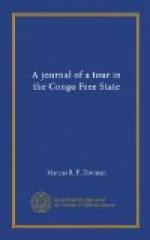At Mokoangai is a large plantation and farm and well built houses for the one or two white men who live there. Next day I start before daybreak hunting. The country is open and hilly, covered generally with grass eight or ten feet high. Still there are many places where the ground is almost bare and it is an ideal spot for stalking game. After walking a few miles in a mist, we see several antelopes and endeavour to stalk them. While still nearly a hundred yards away, they commence to walk slowly towards cover but it is possible to get a fair side shot and one falls heavily hit in the shoulder. Soon after an elephant suddenly appears about two hundred yards ahead walking along the crest of a hill. Sending the native hunter to pick up the antelope, Chikaia and I follow the elephant’s spoor for some hours, but do not come up with it or find other game. We were now high up on the range of hills behind Mokoangai and the view was magnificent. The great river could be seen winding its way between the hills covered with the vivid greens only to be found in damp tropical countries. Otherwise the picture somewhat recalled central Wales with a Wye magnified a hundred times. Chikaia had walked a long way carrying a heavy rifle, and now showed signs of fatigue so he was encouraged by being allowed to shoot a monkey on the way home.
Next day being Sunday, we rest quietly in the Post and prepare to leave next morning in the Aia which is one of the first launches Stanley took to Africa and is therefore, somewhat ancient. Since she is too small to carry much baggage, she tows a large open iron boat nearly the same size alongside. In this the camp is slowed and the boys and soldiers take their places sitting on the bales and cases, and we make a start on Monday September 19th for Banzyville. Fortunately there are no rapids in this stretch of the river and it is at least possible to stand up comfortably in the launch, whereas in the canoes, it was necessary to sit still in a long hammock chair for practically twelve hours each day.
The people and villages now change much in appearance for the huts are shaped like beehives and are made of frameworks of wood covered with grass. The entrance is only about three feet high and the dome of the roof perhaps four times that height. In some of them a kind of platform is erected which seems to be an attempt to make a two storey building of the hut. The women are here either quite nude or wear a small piece of cloth or grass below the waist; the men however all have a loin cloth. All the people seem to be of fine physique and the proportion of children is abnormally high. The first night we stop at a trading post of the Dutch Company on the French side of the river and are hospitably received by the agents there.




